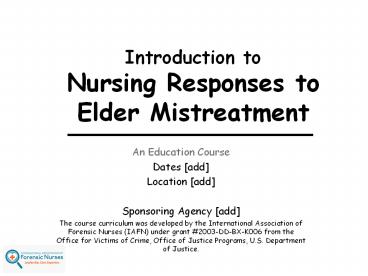An Education Course - PowerPoint PPT Presentation
1 / 19
Title:
An Education Course
Description:
Introduction to Nursing Responses to Elder Mistreatment An Education Course Dates [add] Location [add] Sponsoring Agency [add] The course curriculum was developed by ... – PowerPoint PPT presentation
Number of Views:78
Avg rating:3.0/5.0
Title: An Education Course
1
Introduction to Nursing Responses to Elder
Mistreatment
- An Education Course
- Dates add
- Location add
- Sponsoring Agency add
- The course curriculum was developed by the
International Association of Forensic Nurses
(IAFN) under grant 2003-DD-BX-K006 from the
Office for Victims of Crime, Office of Justice
Programs, U.S. Department of Justice.
2
Nursing Responses to Elder Mistreatment
- Instructor introductions
- Multidisciplinary team approach to teaching
3
Nursing Responses to Elder Mistreatment
- What the course is/covers
4
Participant Introductions
- Name, title/employer, practice setting
- What motivated you to take the course and/or what
do you hope to learn?
5
Administrative Matters
- Microphones
- Cell phones
- Bathrooms, breaks and food/beverages
- Rooms to be used
- Start and end time
- CEU information
- Evaluation
6
Course Goal
- Help nurses acquire essential knowledge and
skills to enhance their ability to recognize and
appropriately respond to actual or potential
elder mistreatment (EM)
7
Course Objectives
- As a result of this course, you will be able to
evaluate - Nursing roles in recognizing and responding to
actual or potential EM - Demographics of older population
- Vulnerability and risk of mistreatment
- Scope/nature of EM
- Relevant laws, regulations, policies and
procedures - Ethical issues
8
Course Objectives (cont.)
- Screening and assessment steps
- Signs of actual or potential EM
- Multidisciplinary team approaches
- Photo-documentation
- Forensic evidence
- Documentation
- Discharge/care transition planning
9
Case Questions
- What do you currently know to help you deal with
these problems? How would you respond to them?
- What are the nursing issues in this case in
relation to actual or potential EM? - In what practice settings might a nurse encounter
EM? How might issues vary across settings? - What do you already know that might help you
appropriately respond to these issues? What do
you still need to know? - What forensic nursing issues arise in this case
study?
10
What is Elder Mistreatment?
- Intentional acts by a caregiver or trusted other
that cause harm/serious risk of harm to a
vulnerable older adult and/or - Failure by a caregiver/trusted other to meet the
basic needs of a vulnerable older adult or
protect her/him from harm. - R. Bonnie R. Wallace, Elder mistreatment,
abuse, neglect and exploitation in an aging
America, 2003
11
Focus on Vulnerable Older Adults
- For courses purpose, vulnerable older adults
have at least one self-care deficit and rely on
trusted others for part or all of their basic
activities of daily living and/or instrumental
activities of daily living
12
Types of Elder Mistreatment
- Neglect
- Physical abuse
- Sexual abuse
- Emotional/psychological abuse
- Abandonment
- Financial exploitation
- Violation of personal rights
13
Areas Not Addressed by Course Except as Applied
to Elder Mistreatment
- Self-neglect
- Other violations against older people
- Mistreatment of younger vulnerable adults
- Primary prevention of EM
14
Nursing Roles in Responding to Elder Mistreatment
- Screen and assess for EM
- Document complaints, history, findings and
interventions - Preserve/minimize damage to forensic evidence.
Coordinate with forensic specialists to collect
evidence - Coordinate with other medical providers and
community agencies as appropriate - Safely transition or discharge the patient
15
Nursing roles (cont.)
- Nursing interventions are most effective when
part of multidisciplinary team response - Overall goal DO NO HARM
16
Forensic Nursing
- A specialty area of nursing in which nurses
provide specialized care for those who have been
affected or are at high risk to be affected by
intentional and unintentional injury - Forensic nurses provide expert patient care while
also attending to medicolegal implications during
a patient encounter
17
Forensic nurses can serve as resources for nurses
to
- Recognize signs of actual or potential EM through
observations of and interactions with patients
and family members or caregivers - Ask questions that elicit information about
actual or potential mistreatment
18
Forensic nurses can serve as resources for nurses
to (cont)
- Fulfill requirements for mandated reporting to
law enforcement and/or regulatory agencies - Documenting findings (written and photographic)
- Collect and preserve evidence
- Initiate safety planning as needed
- Know when to contact a forensic nurse specialist
for assistance
19
Closing Assessment
- Write down one major concept you learned from
this module and how you will apply it in your
practice

